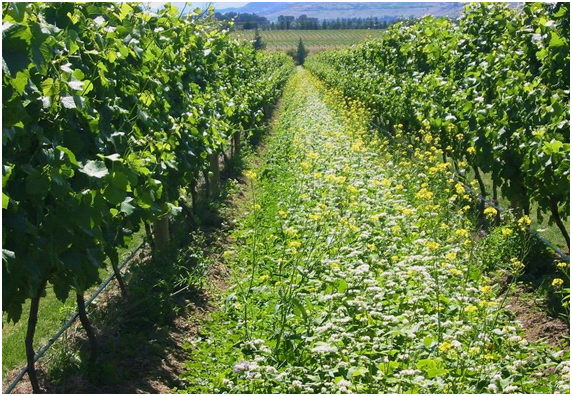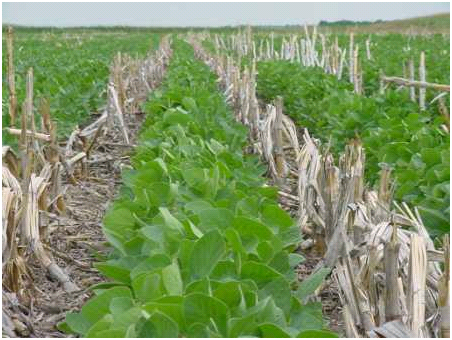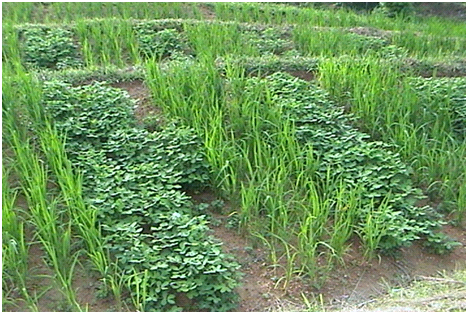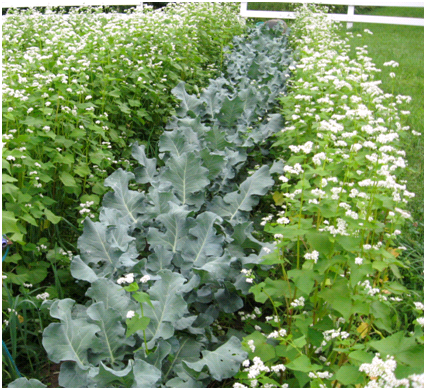
Wednesday, February 24, 2016
A Cover crop is a crop which planted to manage soil erosion, soil fertility, soil quality, water, weeds, pests, diseases and biodiversity in an ecosystem. Cover crop charge your soil and improve soil nutrients. Here is what you need to know about cover crop planting methods and reliable cover crop options for your organic home garden or farm..
There are three main ways to improve soil: grow cover crops, mulch the surface with biodegradable mulches, dig in organic soil amendments (such as compost, grass clippings, rotted manure or wood chips). All have their advantages and none should be discounted, but cover cropping is the method least likely to be practiced in home gardens. There is a reason for this: Information on using cover crops is tailored to the needs of farmers who use tractors to make short work of mowing down or turning under cover crops. But when your main tools for taking down plants have wooden handles and you measure your space in feet rather than acres, you need a special set of cover crop plants, and special methods for using them.
How Cover Crops Help
A cover crop is any plant grown for the primary purpose of improving the soil. Since the early 1900s, farmers have used cover crops to restore fertility to worn-out land. In addition to helping bulk up soil with organic matter, cover crops prevent erosion, suppress weeds, and create and cycle soil borne nutrients using the power of the sun. Recent advances in soil biology have revealed two more ways cover crops can improve soil.
Rhizodeposition is a special advantage to working with cover crops. Many plants actually release sugars and other substances through their roots. They are like little solar engines, pumping energy down into the soil. With vigorous cover crop plants, this process goes on much more deeply than you would ever dig — 6 feet for oats and rye! If you are leaving your garden beds bare in winter, you are missing the chance to use cold-hardy crops such as cereal rye or oats to solar-charge your soil. Thanks to this release of sugars, the root tips of many plants host colonies of helpful microorganisms, and as the roots move deeper, the microbes follow.

But so much for scientific talk. If you’ve experimented with cover crops, perhaps you have dug up young fava beans or alfalfa seedlings to marvel at the nitrogen nodules on their roots, or watched a stand of buckwheat go from seed to bloom in four weeks flat. Or how about this one: It’s April and the soil is warming up and drying out. After loosening a clump of fall-sown wheat with a digging fork, you pull up a marvelous mop of fibrous roots and shake out the soil. What crumb! The soil’s structure is nothing short of amazing! These are the moments an organic gardener lives for. Use certified organic inputs for proper growth of plant in your garden.
Bio-drilling is what happens when you use a cover crop’s natural talents to “drill” into compacted subsoil. For example, you might grow oilseed or daikon radishes as a cover crop where their spear-shaped roots will stab deep into tight subsoil. Bio-drilling action also takes place when deeply rooted cover crop plants penetrate subsoil and die. Then, the next crop grown may actually follow the rooting network mapped out by the cover crop. Maryland researchers were able to track this process using special camera equipment (a minirhizotron), which took pictures of the interactions between cover crop (canola) and crop plant (soybean) roots. As the canola’s deep roots decomposed, soybean roots followed the trails they blazed in the subsoil, hand in glove. In addition to reduced physical resistance, the soybean roots probably enjoyed better nutrition and the good company of legions of soil-dwelling micro critters, compliments of the cover crop.
Dozens of plants have special talents as cover crops, and if you live in an extremely hot, cold, wet or dry climate, you should check with your local farm store or state extension service for plant recommendations — especially if you want to use cover crops under high-stress conditions. Also be aware that many cover crop plants can become weedy, so they should almost always be taken down before they set seed.
How to Take Cover Crops Down
Speaking of taking down, this is the sticking point for most gardeners when it comes to cover crops, which is why it’s a good idea to start small with your first cover crop plantings. Traditionally, cover crops are plowed under, but most gardeners chop, cut, or pull them, and use them for mulch or compost. Or you can assign the task to a flock of pecking poultry. All are sound methods, and it is possible that composting cover crop plants produces a more balanced soil amendment compared to chopping raw-crop residue directly into the soil. Pulling plants saves time, too, because you don’t have to wait three weeks (or more) to plant, in order to avoid possible negative reactions between rotting plant residues and the plants you want to grow. For example, the cover crop known as sudex (a fast-growing sorghum-Sudan grass hybrid) produces gargantuan amounts of biomass (leaf, stem, and roots), but fresh sudex residue in the soil inhibits the growth of tomatoes, lettuce, and broccoli. Oats, wheat, and other cover crop plants also produce allelopathic substances that can temporarily hinder the germination and growth of other plants, too, but not in quantities sufficient to cause serious disturbances in the garden. If you chop in fresh cover crop residues, just plan to wait two to three weeks before sowing crop seeds

Top Cover Crop Options
The following cover crops work well in a wide range of climates and situations, and they’re not hard to take down, as long as you do it at the right time and in the proper way. We’ve selected these six because they are easy to manage using hand tools, grow during different seasons, and provide multiple benefits in the garden.

During the summer, buckwheat (Fagopyron esculentum) is in a class by itself as a cover crop. Seeds sown in moist soil turn into a weed-choking sea of green within a week, with many plants growing 2 feet high or more and blooming in less than 30 days. Should you need to reclaim space that has been overtaken by invasives, buckwheat can be your best friend. In my garden, buckwheat has been a huge ally in cleaning up a spot overrun by dock, bindweed, and other nasties that grow in warm weather. For two years, each time the noxious weeds grew back, I dug them out and planted more buckwheat. Throughout the battle, the buckwheat attracted bees and other buzzers in droves. Fortunately, even mature buckwheat plants are as easy to take down as impatiens — simply pull the succulent plants with a twist of the wrist, or use a hoe or scythe to slice them off at the soil line. You can let the dead plants die into a surface mulch and plant through them, gather them up and compost them, or chop them into the soil. Tags:
- Tags: organic home garden,compost,Organic Matter,Certified organic Inputs



